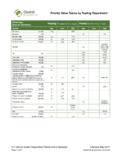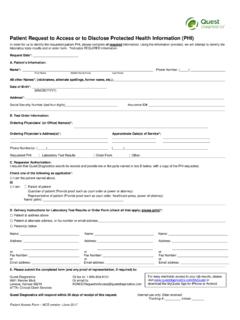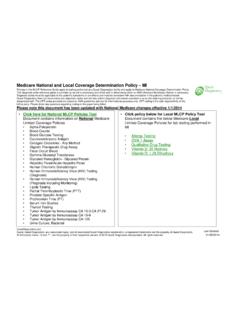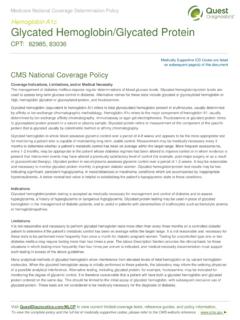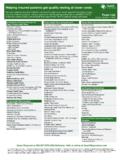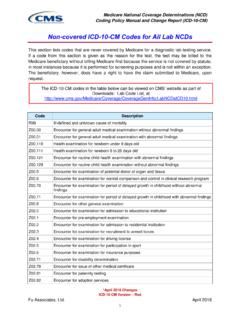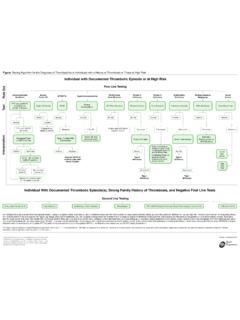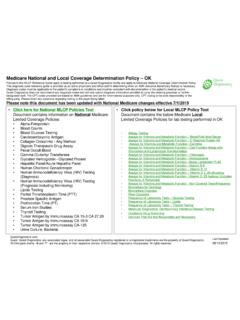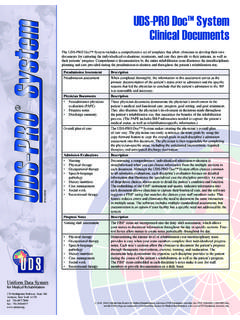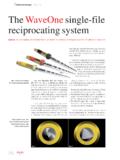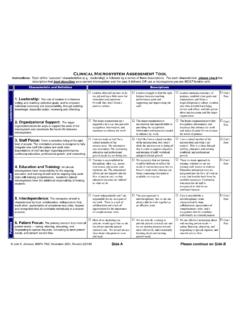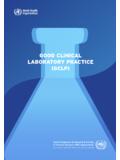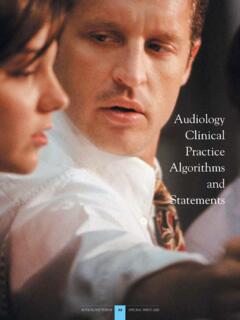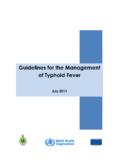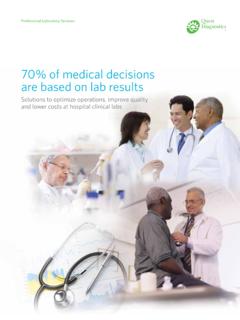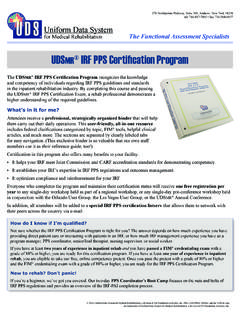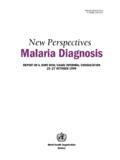Transcription of International System of Units (SI Units) - Quest Diagnostics
1 SI Units339 International System of Units (SI Units )Syst me International d unit s, or SI Units , are an extension of the meter, kilogram, second, ampere (MKSA) System proposed in 1950. In 1966, the International Federation of Clinical Chemistry (IFCC) recommended the use of selected, or favored, SI Units for the clinical laboratory: whenever possible, use mole and liter Units to express concentra-tion, and express whole- unit multiples of three as powers of ten (eg, millimole = 10 3 moles, micromole = 10 6 moles, nanomole = 10 9 moles, picomole = 10 12 moles). This approach was designed to provide clearer quantitative relationships among molecular species and some standardization of databases.
2 This partial application of SI Units to laboratory data has been accepted by many scientifi c journals and is used increasingly in day-to-day clinical medicine. The operative words are whenever possible. In many instances the molecular weight or the homogeneity of the measured analyte is not clear, and gravimetric Units rather than molar Units are pre-ferred. With regard to laboratory reports, we remain in a transition state between conventional (gravimetric) Units and SI Units . Quest Diagnostics is moving to SI Units but continues to use selected conventional Units during what has become a prolonged transition period. For your convenience, we have included a guide for interconversion of conventional and SI Units , along with defi nitions of abbreviations used.
3 The following table lists gravimet-ric and possible International unitage for a variety of laboratory tests. The conversion factor (CF) is used as follows:gravimetric CF = International unitinternational CF = gravimetric unitAbbreviation Defi nitionBCE bone collagen equivalentcreat creatinined daydL deciliterg gramh hourIU International unitskat katal (mol/s)L litermg milligrammin minutemL millilitermL/h milliliter/hourmol molemmol millimole mIU milli International unitsng nanogrampg picogrampmol picomoles secondU Units g microgram mol micromole U microunitsy 3396/1/12 9:52 AM6/1/12 9.
4 52 AM340 Part 4 Analyte Gravimetric Conversion International unit Factor UnitACTH pg/mL pmol/LAlbumin g/dL mg/L g/dL 10 g/LAldosterone, S ng/dL nmol/LAldosterone, U g/24 h nmol/dAlkaline Phosphatase, Bone Specifi c g/L g/LAlpha Subunit ng/mL g/L3 -Androstanediol Glucuronide ng/dL nmol/LAndrostenedione ng/dL nmol/LAngiotensin Converting Enzyme U/L Kat/LAngiotensin II ng/L ng/L1,5-Anhydroglucitol (1,5-AG)
5 G/mL mol/LAnti-M llerian Hormone ng/mL pmol/LApolipoprotein A1 mg/dL g/LApolipoprotein B mg/dL g/LArginine Vasopressin pg/mL pmol/LB-Type Natriuretic Peptide pg/mL ng/LC-peptide, 24-h U g/g creat nmol/mmol creatC-Peptide, S ng/mL nmol/LCalcitonin pg/mL ng/LCalcium, Ionized mg/dL mmol/LCalcium, S mg/dL mmol/LCalcium, U mg/24 h mmol/d mg/g creat mmol/mol creat mg/mg creat mmol/mmol creatCatecholamines, PEpinephrine pg/mL pmol/LNorepinephrine pg/mL pmol/LDopamine pg/mL pmol/LCatecholamines, UEpinephrine g/24 h nmol/dNorepinephrine g/24 h nmol/dDopamine g/24 h nmol/dEpinephrine g/g creat mol/mol creatNorepinephrine g/g creat mol/mol creatDopamine g/g creat mol/mol creatCholesterol, HDL mg/dL mmol/LCholesterol.
6 HDL Subclasses mg/dL mmol/LCholesterol, LDL, Direct mg/dL mmol/LS, serum; U, urine; P, plasma; ACTH, adrenocorticotropic 3406/1/12 9:52 AM6/1/12 9:52 AMSI Units341 International System of Units (SI Units )Analyte Gravimetric Conversion International unit Factor UnitCholesterol, Total mg/dL mmol/LChromogranin A ng/mL g/LCollagen Cross-Linked nmol BCE/ nmol BCE/N-Telopeptide (NTx)
7 Mmol creat mmol creatCollagen Type 1 C-Telopeptide (CTx) pg/mL ng/LCorticosterone ng/dL nmol/LCorticotropin Releasing Hormone pg/mL ng/LCortisol Binding Globulin mg/L nmol/LCortisol, Free, S g/dL nmol/LCortisol, Free, U g/24 h nmol/d g/g creat mol/mol creatCortisol, S and Saliva g/dL nmol/LCortisone, S g/dL mol/LCortisone, U g/24 h mmol/dCreatinine mg/dL mol/L g/24 h mmol/dCyclic AMP.
8 Urine nmol/mL mol/LCystatin C mg/L mg/LDeoxycorticosterone ng/dL nmol/L11-Deoxycortisol ng/dL nmol/LDexamethasone ng/dL pmol/LDHEA ng/dL nmol/L g/24 h mol/d g/g creat mol/mol creatDHEA Sulfate g/dL mol/LDihydrotestosterone ng/dL nmol/LDihydrotestosterone, Free pg/mL pmol/LEstradiol (E2), Free pg/mL pmol/LEstradiol (E2)
9 , S pg/mL pmol/LEstrogen, Total, S pg/mL ng/LEstrogens, Fractionated, SEstrone pg/mL pmol/LEstradiol pg/mL pmol/LEstriol ng/mL nmol/LEstrone (E1), S pg/mL pmol/LEstrone Sulfate pg/mL pmol/LFructosamine mol/L mol/LFSH mIU/mL IU/LS, serum; U, urine; P, plasma; DHEA, dehydroepiandrosterone.
10 FSH, follicle stimulating 3416/1/12 9:52 AM6/1/12 9:52 AM342 Part 4 Analyte Gravimetric Conversion International unit Factor UnitGAD-65 Antibodies U/mL kU/LGastrin pg/mL ng/LGlucagon
